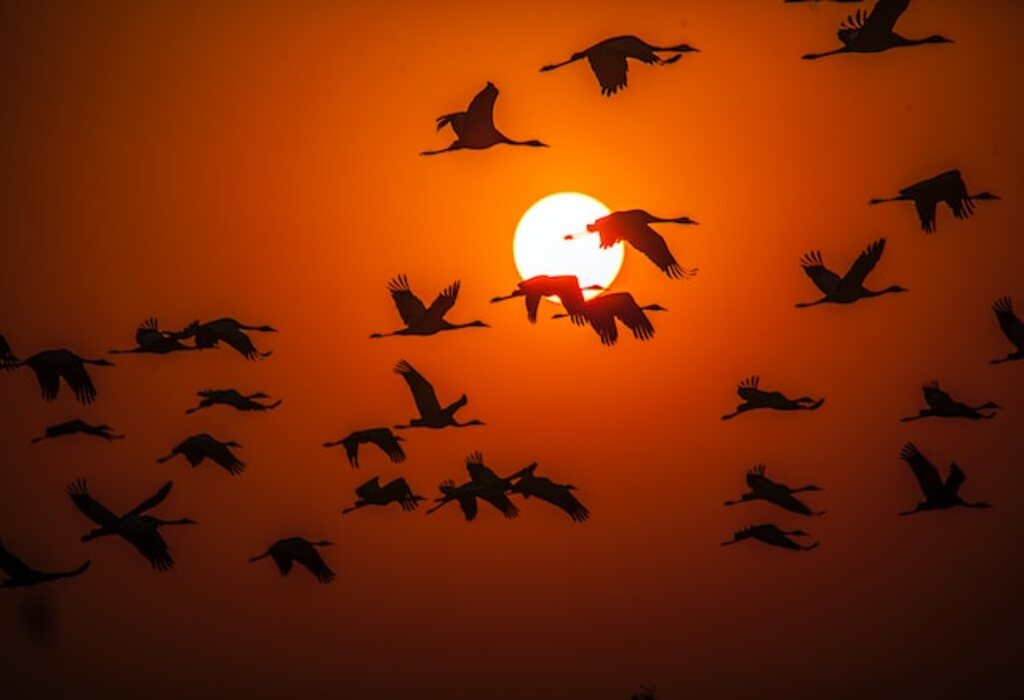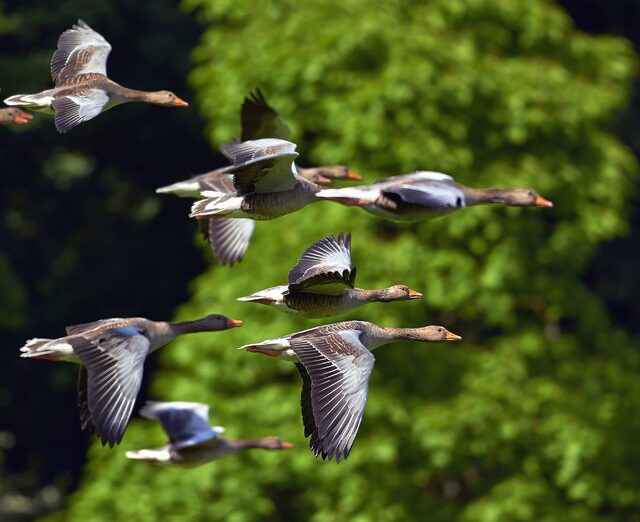Bird migration is a remarkable phenomenon that has fascinated humans for centuries. Simply put, bird migration refers to the regular, seasonal movement of birds from one place to another. These movements can involve long distances, with some birds traveling thousands of miles between their breeding and wintering grounds.
So, how far do birds migrate? The answer varies depending on the species, but some birds can travel incredible distances. For instance, the Arctic Tern is known to make the longest migration of any bird, flying from its breeding grounds in the Arctic to its wintering grounds in the Antarctic and back again each year. This journey covers a distance of over 44,000 miles!
Table of Contents
- 1 Key Takeaways:
- 2 How Far Do Birds Migrate?
- 3 Exploring Bird Migration Patterns
- 4 Understanding Long-Distance Bird Migration
- 5 The Seasons of Bird Migration
- 6 Fascinating Bird Migration Facts
- 7 The Incredible Journeys of Migratory Birds
- 8 Factors Influencing Bird Migration
- 9 Tracking Bird Migration
- 10 The Impacts of Climate Change on Bird Migration
- 11 Conclusion
- 12 FAQs: How Far Do Birds Migrate?
- 12.1 How far do birds migrate?
- 12.2 What are bird migration patterns?
- 12.3 How do birds decide their migration routes?
- 12.4 Do all bird species migrate long distances?
- 12.5 When do birds migrate?
- 12.6 How do scientists track bird migration?
- 12.7 What are some impacts of climate change on bird migration?
- 12.8 Why do birds migrate long distances?
- 12.9 Why is understanding bird migration important?
- 13 Author
Key Takeaways:
- Bird migration refers to the seasonal movement of birds from one place to another.
- Some bird species can travel incredible distances during their migrations, with the Arctic Tern making the longest migration of any bird.
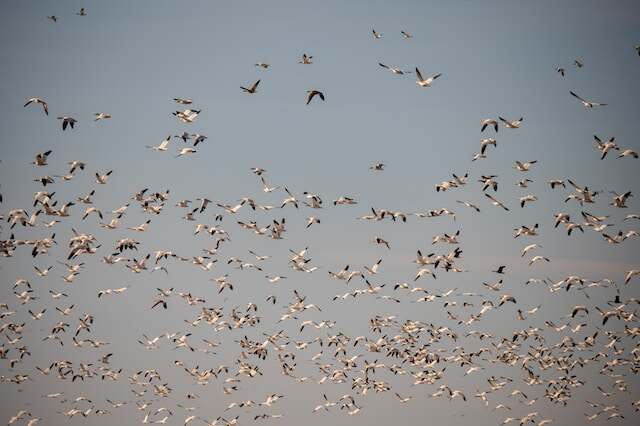
How Far Do Birds Migrate?
Birds migrate varying distances depending on the species and their specific migration patterns. Some birds, such as the Arctic Tern, can travel up to 44,000 miles round trip during their annual migration.
Other birds, like the American Robin, may only migrate a few hundred miles. The distance of a bird’s migration is largely determined by factors such as food availability, weather patterns, and breeding grounds.
Exploring Bird Migration Patterns
Migration is a fascinating and complex phenomenon observed in numerous species, including birds. Migratory bird species are those that undertake regular seasonal movements between breeding and non-breeding grounds, typically following established routes and patterns. Understanding bird migration patterns is crucial for conservation efforts and better appreciation of the natural world.
Migratory Bird Species
Over 4,000 bird species are known to undertake some sort of migration, with over 350 species migrating regularly between the Arctic and the tropics. These migratory birds include songbirds, waterfowl, raptors, shorebirds, and others. Different species migrate at different times, with some species migrating only at night and others during the day.
Some birds, such as the Arctic Tern, undertake incredibly long migrations, covering over 44,000 miles annually. Other birds, like the Bar-tailed Godwit, can fly for up to nine days straight without stopping. The distance and duration of bird migrations depend on the species, their breeding and wintering grounds, and the routes they take.
Factors Influencing Bird Migration Patterns
The patterns of bird migration are influenced by various factors, including food availability, weather patterns, and breeding cycles. Food availability is a critical factor, as birds need to find suitable feeding grounds along their migratory routes to survive. Weather patterns can also impact migration, with changing wind and weather conditions affecting the timing and direction of bird movements.
Birds’ breeding cycles are also instrumental in shaping migration patterns. Many birds time their movements to coincide with breeding seasons, traveling to breeding grounds to mate and nest before returning to non-breeding grounds for the winter. The availability of suitable breeding and nesting habitats is another crucial factor influencing migratory bird species.
Summary
Understanding the patterns of bird migration is essential for conservation efforts and the preservation of the natural world. It is vital to continue studying migratory bird species and their habitats to ensure their survival and to provide better protection for these incredible birds.
Understanding Long-Distance Bird Migration
Bird migration is a fascinating phenomenon, with some species traveling incredible distances each year. Long-distance bird migration, in particular, is a remarkable feat of endurance and navigation.
During their journeys, migratory birds follow established migration routes, some of which span thousands of miles and cross oceans and continents. These routes are influenced by a range of factors, including food availability, weather patterns, and geographic barriers.
Many long-distance migratory birds are capable of covering enormous distances. For example, the Arctic Tern has the longest migration route of any bird, traveling over 44,000 miles between its Arctic breeding grounds and its Antarctic wintering grounds. Other notable long-distance migrants include the Bar-tailed Godwit, which flies over 7,000 miles from Alaska to New Zealand, and the Ruby-throated Hummingbird, which crosses the Gulf of Mexico during its migration.
Migratory birds are able to navigate these incredible distances through a range of strategies, including celestial navigation, olfactory cues, and memorization of landmarks. Some species, such as the Arctic Tern, are even able to detect the earth’s magnetic field, using it to guide their migrations.
Overall, long-distance bird migration is a complex and fascinating topic, with much still to be discovered about the factors that influence migration routes and the mechanisms that allow birds to navigate vast distances.
The Seasons of Bird Migration
The seasonal aspects of bird migration are a crucial component of this natural phenomenon. While many birds migrate to escape harsh winter conditions, others undertake journeys during the breeding season, in search of optimal conditions to raise their young.
In North America, bird migration is most noticeable during spring and fall as birds travel to and from breeding grounds. The majority of migratory birds in the Northern Hemisphere migrate north in the spring to take advantage of increased food availability and favorable weather conditions. In the fall, they travel south to find warmer climates and abundant food sources in preparation for the winter.
Global bird migration is also influenced by seasonal changes. For example, the Arctic Tern travels from its breeding grounds in the Arctic to its wintering grounds in the Antarctic, covering a distance of up to 44,000 miles each year. This incredible migration is influenced by the seasonal availability of food and changing day length.
It’s important to note that not all bird species migrate. Some species, such as the American Robin, live in regions with mild winters and do not need to travel long distances to find food and shelter.
Fascinating Bird Migration Facts
Bird migration is a truly remarkable phenomenon that has fascinated scientists and bird enthusiasts for centuries. Here are some interesting facts about bird migration:
- The Arctic Tern holds the record for the longest migration of any bird species, traveling a round-trip distance of up to 44,000 miles between its breeding grounds in the Arctic and its wintering grounds in Antarctica.
- The Ruby-throated Hummingbird is the only species of hummingbird that breeds in the eastern United States and then migrates across the Gulf of Mexico to spend the winter in Central America.
- Many bird species use the earth’s magnetic field to navigate during migration. They have tiny crystals of a magnetic mineral called magnetite in their beaks, which helps them sense the magnetic field.
- The Bar-headed Goose is one of the only bird species that can fly over the Himalayas, the tallest mountain range in the world.
- Certain species of raptors, such as the Turkey Vulture and the Swainson’s Hawk, rely on thermals (rising columns of warm air) to gain altitude and then glide long distances during migration.
- Some bird species, such as the Northern Wheatear, undertake some of the longest non-stop flights of any bird, flying continuously for up to several days without stopping to rest or eat.
- The timing of bird migration is often influenced by changes in day length, with most species beginning their migrations in the fall when days get shorter and food becomes scarcer.
- The Arctic is home to some of the most spectacular bird migrations in the world, with millions of birds flying north each spring to breed in the vast tundra regions of Alaska, Canada, and Russia.
These are just a few of the many fascinating facts about bird migration. The more we learn about this incredible phenomenon, the more we can appreciate and protect these amazing creatures.
The Incredible Journeys of Migratory Birds
Migratory bird species undertake some of the most remarkable journeys in the animal kingdom, traveling thousands of miles between their breeding and wintering grounds. These journeys can be perilous, with birds facing numerous challenges along the way, including weather patterns, predators, and loss of habitat.
The Arctic Tern
One of the most impressive migratory bird species is the Arctic tern. These birds have the longest migration of any animal, traveling up to 44,000 miles each year from their breeding grounds in the Arctic to their wintering grounds in the Antarctic. This journey takes the birds across the entire globe and back, following a zigzagging route that avoids the open ocean.
The Arctic tern’s migration is fueled by a remarkable ability to fly for long periods without stopping. The birds can stay in flight for up to three years without touching down, taking advantage of the winds and currents to propel them along their route.
The Ruby-Throated Hummingbird
Another migratory bird species that travels incredible distances is the ruby-throated hummingbird. These tiny birds weigh only a few grams but undertake a journey of up to 2,000 miles from their breeding grounds in eastern North America to their wintering grounds in Central America.
To complete this journey, the ruby-throated hummingbird must cross the Gulf of Mexico, a feat that requires non-stop flying for up to 18 hours. During this flight, the birds can lose up to half of their body weight, relying on fat stores to fuel their journey.
The Bar-Tailed Godwit
The bar-tailed godwit is another species that undertakes an impressive migration, flying up to 7,000 miles between its breeding and wintering grounds. These birds breed in Alaska and spend the winter in New Zealand, undertaking a non-stop flight across the Pacific Ocean.
Recent research has shown that the birds are able to fly for such long periods by reducing their body mass and metabolic rate, essentially entering a state of suspended animation. This allows them to conserve energy while in flight, enabling them to make the journey without stopping.
The Importance of Understanding Bird Migration Routes
Understanding the migration routes of these and other migratory bird species is crucial for conservation efforts. Many migratory bird populations are declining due to habitat loss, climate change, and other factors, making it essential to protect the areas they depend on during their migration.
By studying these incredible journeys, scientists can gain new insights into the behavior and ecology of migratory bird species, helping to develop better conservation strategies to protect these remarkable creatures for future generations to enjoy.

Factors Influencing Bird Migration
Bird migration is a fascinating phenomenon that has long puzzled scientists and bird enthusiasts alike. But what drives birds to make these incredible journeys, sometimes spanning thousands of miles? Here are some of the key factors that influence bird migration:
Food Availability
One of the primary reasons birds migrate is to find food. As the seasons change and temperatures shift, the availability of food sources can fluctuate dramatically. Some birds, such as warblers, feed mainly on insects, which can become scarce in colder months. Others, such as waterfowl, rely on aquatic vegetation that may become inaccessible as water freezes over. By traveling to new locations, birds can find the food they need to survive.
Weather Patterns
Weather plays a critical role in bird migration. Birds typically head south in the fall to avoid the harsh winter weather and return north in the spring when temperatures warm up. However, weather patterns can shift unexpectedly, causing birds to alter their migration routes or timing. For instance, if a storm system moves through an area, it may be too dangerous for birds to continue flying, prompting them to seek shelter.
Breeding Cycles
Some birds migrate to specific locations to breed and raise their young. For instance, many species of waterfowl travel north to wetlands in Canada and Alaska to mate and nest. After their young have fledged, they may return to their wintering grounds. The timing of migration is critical in these cases, as birds need to arrive at their breeding grounds when conditions are ideal for raising young.
Did you know? The Arctic Tern holds the record for the longest migration of any bird, traveling from its breeding grounds in the Arctic to its wintering grounds in Antarctica and back again each year. This journey covers a distance of over 44,000 miles!
Understanding the factors that influence bird migration is critical for conservation efforts. As climate change and habitat loss threaten many bird species, it’s more important than ever to protect the places birds rely on throughout their migratory journeys. By working to preserve important stopover sites and breeding grounds, we can help ensure that migratory birds continue to make these incredible journeys for generations to come.
Tracking Bird Migration
Understanding bird migration is no easy feat, but thanks to advances in technology and research methods, scientists have been able to track the patterns and routes of migratory birds. By studying the movements of these feathered travelers, researchers can gain valuable insights into the factors that influence migration and the challenges these birds face along the way.
One of the most effective ways to track bird migration is through the use of satellite tracking. GPS technology allows researchers to attach small tracking devices to individual birds, which transmit location data as the bird flies. By analyzing this data, scientists can track the migration routes of entire populations of birds, identifying key stopover points and migration corridors.
Banding studies are another important method of tracking bird migration. Bands are small metal rings that are placed on the legs of birds, allowing researchers to identify and track individuals over time. By recapturing banded birds, researchers can gather data on migration timing, routes, and even individual behavior patterns.
Tracking Bird Migration: Challenges and Limitations
While tracking technology has revolutionized our understanding of bird migration, there are still many challenges and limitations to this research method. One major challenge is the size and weight of tracking devices. While GPS tags have become much smaller and lighter in recent years, they can still cause significant interference with the bird’s natural behavior and movement.
Another limitation is the cost of tracking devices and the logistics of tracking large numbers of birds. While satellite tracking is highly effective, it can be expensive to purchase and maintain the necessary equipment. Additionally, tracking large populations of birds requires careful planning and collaboration between researchers across different regions and countries.
Summary
Tracking bird migration is a complex and challenging endeavor, but one that provides valuable insights into the behavior and ecology of migratory bird species. As technology continues to advance, our understanding of bird migration patterns and routes will only continue to improve, helping us to better protect these incredible feathered travelers.
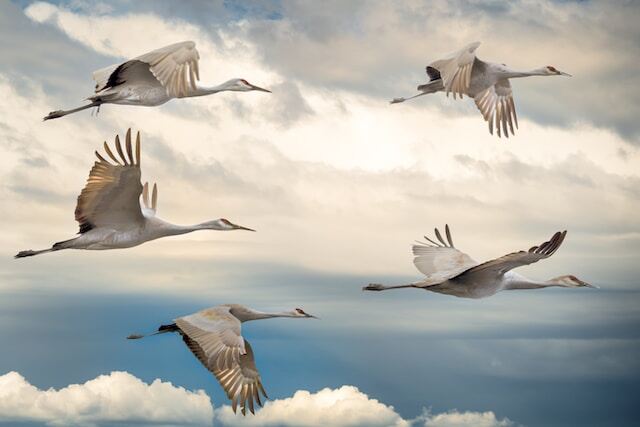
The Impacts of Climate Change on Bird Migration
Bird migration patterns and global bird migration are being impacted by climate change. As the planet’s temperature increases, the timing, routes, and behaviors of migratory birds are changing. These changes are having a significant impact on bird populations and ecosystems.
Changes in Timing
One of the most significant impacts of climate change on bird migration is changes in timing. Many migratory birds rely on seasonal cues, such as temperature and day length, to signal when it is time to migrate. As temperatures shift, these cues become less reliable, causing birds to migrate earlier or later than usual.
For example, some studies have shown that some European bird species are migrating an average of two weeks earlier than they were 40 years ago. This shift can cause birds to arrive at their breeding grounds before food sources are available, potentially impacting their ability to survive and reproduce.
Changes in Routes
Climate change is also altering bird migration routes. Some species are shifting their paths to follow changes in weather patterns or food availability. For example, researchers have observed Arctic-breeding shorebirds shifting their migration routes to take advantage of changing patterns of snowmelt.
These changes in routes can impact both the birds and the ecosystems they pass through. For example, if a species shifts its migration route to a new area, it may encounter new predators, competitors, or food sources. This can have ripple effects throughout the ecosystem.
Impact on Populations
Changes in migration patterns and routes can have significant impacts on bird populations. For example, if a species arrives at its breeding grounds before the food sources it relies on become available, it may struggle to survive and reproduce. This can lead to declines in population.
Additionally, some species may be more resilient to climate change than others. If a species is unable to adapt to changing conditions, it may struggle to survive.
Summary
Climate change is having a significant impact on bird migration patterns and global bird migration. As temperatures continue to rise, these impacts are likely to become more pronounced. Understanding how and why bird migration is changing is critical to developing effective conservation strategies and protecting these important species and ecosystems.
Conclusion
In conclusion, bird migration is a fascinating and complex phenomenon that plays a critical role in our planet’s ecosystem. From the incredible distances that birds cover during their journeys to the different factors that influence their migration patterns, there is much to learn and appreciate about these incredible birds.
As we have seen, bird migration is a global phenomenon, with different species undertaking long and arduous journeys across continents and oceans. It is important to understand the timing and routes of bird migration, as well as the influences that impact these movements.
Tracking bird migration through satellite technology and banding studies has provided scientists with valuable insights into the patterns and behaviors of migratory birds.
This research has also highlighted the potential impacts of climate change on bird migration, with shifts in timing and routes potentially having significant consequences for migratory bird populations.
As we continue to learn more about bird migration, it is important to appreciate the beauty and complexity of these journeys and to support efforts aimed at conserving migratory bird populations.
By protecting the habitats and ecosystems that support these birds, we can help ensure that future generations can continue to marvel at the incredible journeys of migratory birds.
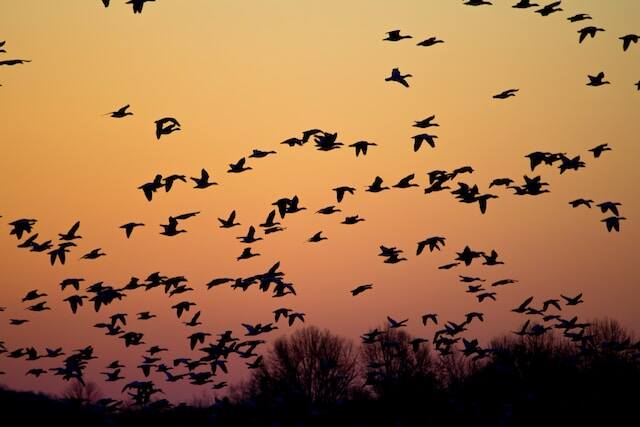
FAQs: How Far Do Birds Migrate?
How far do birds migrate?
The distance that birds migrate can vary greatly depending on the species and their specific migratory routes. Some birds may travel just a few hundred miles, while others can cover thousands of miles during their migrations.
What are bird migration patterns?
Bird migration patterns refer to the regular movements that certain species of birds undertake, typically on a seasonal basis. These patterns involve the movement of birds from one geographical area to another, often in search of food, suitable breeding grounds, or more favorable climates.
How do birds decide their migration routes?
Birds use a combination of innate navigational abilities, celestial cues, and environmental signals to decide their migration routes. These routes are often determined by factors such as food availability, weather patterns, and geographic obstacles.
Do all bird species migrate long distances?
No, not all bird species migrate long distances. While some species undertake long and arduous journeys, others may only travel short distances or not migrate at all. Migration is a behavior that has evolved over time in certain species as an adaptive strategy.
When do birds migrate?
The timing of bird migration can vary depending on factors such as species, geographical location, and seasonal changes. Generally, birds migrate during the spring and fall seasons, with spring migrations typically focused on breeding grounds and fall migrations geared towards finding food-rich wintering areas.
How do scientists track bird migration?
Scientists employ various methods to track bird migration, including the use of satellite tracking devices, banding studies, and radar technology. These methods provide valuable insights into the routes, timing, and behaviors of migratory birds.
What are some impacts of climate change on bird migration?
Climate change is impacting bird migration patterns in a number of ways. Shifts in temperature and weather patterns can affect the availability of food and alter the timing of migration. Additionally, changes in habitats and the potential disruption of established migration routes pose challenges for migratory bird populations.
Why do birds migrate long distances?
Birds migrate long distances to take advantage of favorable conditions for feeding and breeding. By moving to areas with abundant resources and suitable habitats, birds increase their chances of survival and reproductive success.
Why is understanding bird migration important?
Understanding bird migration is important for several reasons. It provides insights into the ecological and evolutionary processes that shape bird populations and ecosystems. Additionally, studying bird migration can help inform conservation efforts, as it allows us to identify crucial habitats and protect important stopover sites.

